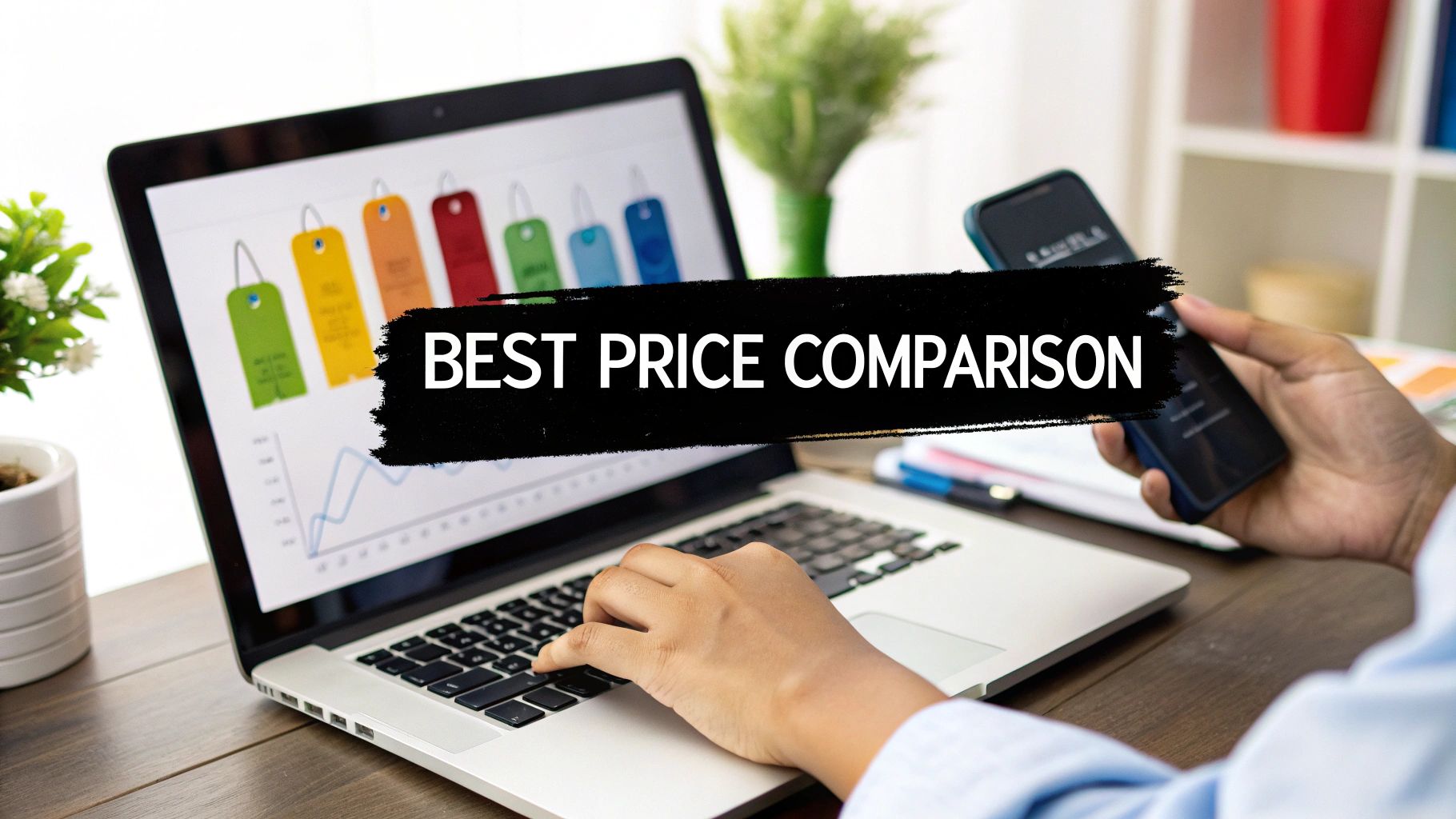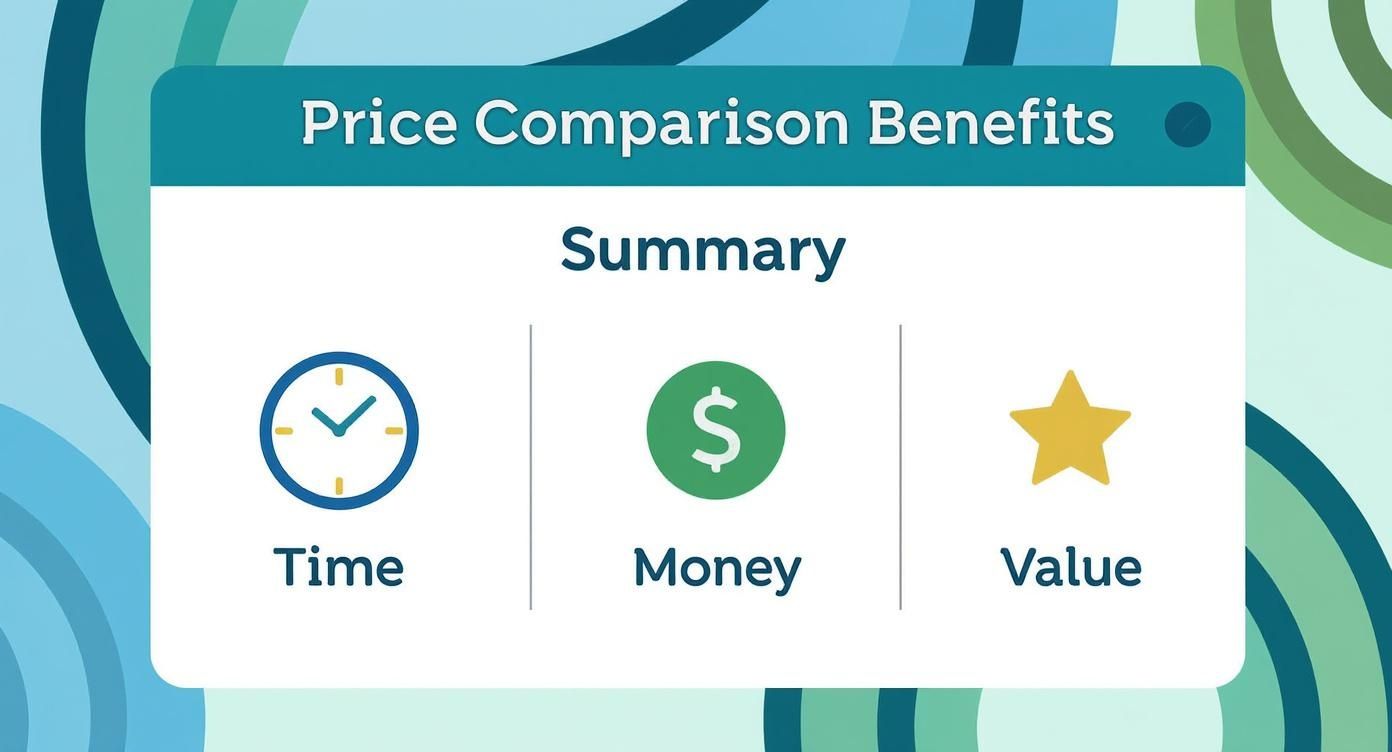
If you're looking to get the best deal, price comparison websites are your secret weapon. You've got the heavyweights like Google Shopping with its incredible reach, laser-focused tools like CamelCamelCamel for tracking Amazon prices, and browser extensions like Honey that hunt down coupons for you at checkout. They all work to bring prices from countless online stores into one place, making sure you never overpay.
How Price Comparison Websites Save You Money
Let's be honest, finding the best price online can be a real grind. You end up with a dozen tabs open, trying to manually compare prices and shipping costs. This is where price comparison sites come in. They act like a powerful search engine specifically for deals, instantly showing you who’s selling your desired item for the lowest price.
What started as simple price lists has evolved into a full-blown toolkit for any serious shopper. The whole point is to give you a clear, unbiased look at the market for a specific product. By pulling all that data together, these sites put the power back in your hands, whether you're buying groceries or a new laptop.
This image shows a classic example of what you'll see: one product, listed with several different retailers and their prices, side-by-side.
The magic is in the simplicity. You can see the price differences at a glance and immediately spot the best deal without any of the legwork.
The Growing Influence of Comparison Shopping
These tools aren't just a niche gimmick anymore; they're a massive part of how we shop. The global market for price comparison websites is on track to hit $15 billion in 2025, and it's estimated that over 20% of all global retail sales will happen online. This isn't a fleeting trend—it's a fundamental shift in consumer behavior. You can dive deeper into these market trends over at Archive Market Research.
So, what's the big draw? It really boils down to a few key benefits:
- You Save a Ton of Time: Why spend an hour searching when a website can give you prices from dozens of stores in seconds?
- You Shop Smarter: It’s not just about price. You get user reviews and detailed product information all in one place.
- You Get the Best Value: Seeing all your options ensures you’re not leaving money on the table. For instance, travelers looking for cheap all-inclusive resorts can use these sites to compare packages and find incredible deals they might have otherwise missed.
Modern comparison sites have even more tricks up their sleeve. Many offer price drop alerts that let you track an item and get an email the second it goes on sale. It's a simple way to turn your wishlist into a list of incredible bargains.
Picking the Right Tool: What to Look for in a Price Comparison Website
Not all price comparison sites are built the same. When you get down to it, the best ones do more than just show you a list of prices. They're powerful shopping assistants. From my experience, the truly great platforms nail three things: the size of their retailer network, how fast and accurately they update prices, and how easy they are to use.
Think about it—a wide network of stores means you're getting the full story, not just a curated list from the biggest names. Price accuracy is also a deal-breaker. There's nothing worse than finding a fantastic deal, only to click through and discover it expired hours ago. And of course, a clean, simple interface with good filters makes the whole process feel effortless instead of like a chore.
The best tools really do deliver on multiple fronts, which is what makes them so valuable for savvy shoppers.

As the infographic shows, it’s about more than just finding a lower price tag. It's about saving time, getting more value for your money, and making smarter purchasing decisions overall.
Head-to-Head: Comparing the Top Players
To figure out which of the best price comparison websites is right for you, we need to put them side-by-side. Each one has its own strengths and is built for a certain type of shopper.
Google Shopping is the 800-pound gorilla in the room, and for good reason. Because it's baked right into the world's biggest search engine, its reach is immense. You'll find everything from massive department stores to tiny niche boutiques. It's my go-to starting point for almost any general search, giving a fantastic bird's-eye view of the market. Its one weakness? The price history data isn't as robust as some of the more specialized platforms.
On the other end of the spectrum, you have a specialist like CamelCamelCamel. This tool is an absolute must-have for anyone who frequently shops on Amazon. It focuses solely on that one marketplace, which allows it to provide incredibly detailed price history charts. You can see every price dip and spike over an item's lifetime, which is perfect for patient shoppers waiting for the absolute best time to buy. If you want to master these techniques, our guide can show you how to compare prices online and save more.
The best tool for the job really depends on what you're buying. Start broad with Google Shopping for general items, but drill down with a niche tool like CamelCamelCamel when you're focused on a specific retailer like Amazon.
This model of comparing options to save money isn't just for physical products. You can apply the same logic to financial services, as shown in this detailed bank fee comparison guide, which helps people find the most affordable banking options.
For a clearer picture, this table breaks down the key features of these popular platforms.
Feature Comparison of Leading Price Websites
| Website | Best For | Price Alerts | Price History Tracking | Browser Extension |
|---|---|---|---|---|
| Google Shopping | General, broad product searches across a vast network of retailers. | Yes | Limited | No |
| CamelCamelCamel | Amazon shoppers who want deep price history and targeted alerts. | Yes | Excellent | Yes |
| PriceGrabber | Electronics and home goods, with detailed product reports. | Yes | Yes | No |
| Honey | Automatic coupon application at checkout for passive savings. | Yes (via Droplist) | Limited | Yes |
This side-by-side view makes it easy to see how each tool caters to a different shopping style, from the active researcher to the passive saver.
How to Use These Features in the Real World
Knowing the features is one thing, but understanding how they fit into your shopping routine is what really saves you money. A tool might have all the bells and whistles, but it's useless if it doesn't match how you shop.
Take a platform like PriceGrabber. It really excels at pulling in data from tons of different merchants and giving you detailed market rundowns. This makes it a great choice when you're shopping for things like electronics or appliances, where you need to compare specs and prices from several different stores.
Then you have a tool like Honey, which works completely differently. It's a browser extension that runs in the background. Instead of you actively searching, it automatically finds and applies coupon codes when you're at the checkout page. This is ideal for someone who just wants to make sure they're not missing a last-minute discount without doing all the legwork.
Let's walk through a real-world example. Say you're buying a new mirrorless camera.
- You'd start on Google Shopping to get a solid baseline of what major retailers like Best Buy or Adorama are charging.
- Next, you might jump over to PriceGrabber to see if any smaller, specialized camera shops have a better deal.
- Finally, once you've decided where to buy, you'd let Honey run at checkout to automatically test for any valid coupon codes.
By layering these strategies, you're attacking the price from multiple angles and ensuring you get the absolute best deal possible.
How AI Is Changing the Price Comparison Game
Price comparison websites used to be pretty simple—basically just digital lists of who was selling what for how much. But those days are long gone. The best tools today are powered by artificial intelligence, acting less like catalogs and more like smart shopping assistants that actually understand what you're looking for.

This isn't just a minor tweak; it's a complete overhaul of how these platforms work. Modern AI algorithms crunch massive amounts of data—everything from historical price trends and market demand to your own search habits—to create a much more intuitive and helpful experience.
Predictive Pricing and Smarter Alerts
One of the biggest game-changers is the shift from reactive to predictive pricing. Instead of just showing you today's price, sophisticated algorithms can now predict if a product's price is about to go up or down.
Let's say you're eyeing a new TV. An AI-powered site can look at years of data for that model and see a pattern—like the price consistently dropping by 15% a couple of weeks after a big tech conference. It can then advise you to hold off, turning a decent deal into a fantastic one. This makes price alerts a whole lot smarter, pinging you at the perfect time to pull the trigger.
AI fundamentally changes the question from "Is this a good price now?" to "When will be the best time to buy?" It gives shoppers foresight, not just hindsight, offering a real strategic edge in getting the lowest price.
This kind of intelligence is a huge reason the market is booming. The U.S. price comparison market hit $13.35 billion in 2024 and is expected to climb to $21.88 billion by 2032, all because people want smarter ways to shop. You can dig into the numbers in this detailed industry report.
Personalized Deal Recommendations
Beyond just predicting price drops, AI is a master of personalization. By learning from your search history and what you've bought before, these platforms can build a shopping experience that feels like it was made just for you.
Imagine you're hunting for a new pair of running shoes. An AI-driven site doesn't just throw random shoe deals at you. It gets specific.
- It'll flag deals on the exact brands you’ve been looking at.
- It might suggest discounts on related gear, like performance socks or a GPS watch.
- Most importantly, it filters out all the noise and irrelevant offers, saving you a ton of time.
This personal touch means the deals you see are ones you actually care about. The system gets to know your tastes, acting like a personal shopper who scours the web to find the right product at the right price, making the whole process faster and way more effective.
Choosing the Right Tool for Your Shopping Needs

There’s no single "best" price comparison website that works for every single purchase. The real trick is to match the tool to the task at hand. The site that’s perfect for finding the rock-bottom price on a new TV probably won't help you much when you're trying to save on your weekly groceries.
It all comes down to thinking like a specialist. Different platforms are built for different kinds of shoppers, so the first step is knowing what kind of shopper you are. Are you a patient bargain hunter who plays the long game? A tech enthusiast who needs the latest specs? Or are you just looking to effortlessly save a few bucks on daily purchases?
For the Patient Price Tracker
If you’re the type who is willing to wait for the absolute best deal, you need a tool with powerful price history charts and alert systems. You're not just looking for today's cheapest price—you want to know if it's an all-time low.
This is where a specialized tool really proves its worth. For anyone shopping on Amazon, CamelCamelCamel is the undisputed king. Its price history graphs show you every single price fluctuation over months or even years. You can set a price alert for your target and just wait for the email. It's the perfect strategy for non-urgent, big-ticket items where a little patience can literally save you hundreds.
For the Tech and Electronics Buyer
When you're buying electronics, the price is only part of the story. You also need to dig into specs, compare different models, and see who has it in stock. For this, a wide-reaching aggregator is your best bet because it pulls offers from both the big-box giants and smaller, specialized online stores.
Google Shopping is a fantastic starting point. Its sheer size gives you an instant snapshot of the market, putting prices from Best Buy, Walmart, and lesser-known e-tailers all in one place. Another strong contender here is PriceGrabber, which often includes detailed product comparisons to help you weigh features side-by-side before you pull the trigger.
The best tool depends entirely on your timeline and what you're buying. For patient shoppers, historical data is everything. For tech buyers, a wide net of retailers and detailed feature comparisons are what lead to a smart decision.
For the Everyday Deal Hunter
For those of us who just want to save money without a lot of extra effort, a browser extension is the way to go. These tools do the heavy lifting for you, working quietly in the background to find deals and apply coupon codes right when you need them at checkout.
Honey is probably the most famous tool in this category. You don't really visit it like a website; instead, it pops up automatically when you're about to pay. The extension quickly scours the internet for any active promo codes and applies the one that saves you the most money. This "set it and forget it" method is ideal for saving on everyday things from clothes to pizza, making it one of the best price comparison websites for passive, consistent savings.
By picking your tool based on the shopping mission, you’ll move beyond just finding random deals and start building a real strategy for saving money.
Understanding Global Price Comparison Trends
To really get a feel for what the best price comparison websites can do, it’s useful to step back and look at the bigger picture. Shopping habits aren't universal; how someone finds a deal in North America can be wildly different from how they shop in Asia or Europe.
These global currents offer a fascinating glimpse into where the industry is headed. It’s not just about saving a few bucks today—it’s about understanding the innovations and consumer behaviors that are shaping the future of how we all shop online.
The Asia-Pacific E-Commerce Boom
Right now, the Asia-Pacific region is the undisputed engine of the price comparison market, and its growth has been nothing short of explosive. This trend is fueled by massive mobile phone penetration and an e-commerce culture that's deeply woven into daily life. In many of these countries, consumers bypassed the desktop era and jumped straight to mobile, which means shopping on the go isn't just an option; it's the norm.
This mobile-first approach has given rise to some incredibly sophisticated shopping apps and platforms. The result is a market that’s not only huge but also fiercely competitive and constantly evolving.
The global price comparison market is on a steep upward trajectory, expected to climb from $29.6 billion in 2023 to an estimated $59.5 billion by 2033. The Asia-Pacific region is leading the way, claiming over 39.2% of all global revenue. You can dig deeper into these numbers with the full market analysis on market.us.
Contrasting North American and European Habits
While Asia-Pacific is all about mobile-driven growth, shoppers in North America and Europe have their own distinct patterns. In North America, convenience and brand loyalty often play a huge role. Many people start their product search directly on giants like Amazon or Google Shopping. Price is definitely important, but so are perks like two-day shipping and a no-hassle return policy.
European shoppers, on the other hand, often seem more willing to cast a wider net, exploring a variety of retailers and specialized search engines. Cross-border shopping is also much more common. Consumers there are quite comfortable comparing prices from sellers in neighboring countries to snag the absolute lowest price, even if it adds a few days to the shipping time.
Despite these regional differences, one thing is clear: everyone is looking for a deal on gadgets. Electronics remain the top category across the globe, accounting for nearly 46.8% of the market share.
Answering Your Top Questions About Price Comparison
It’s one thing to see the benefits, but it's another to really understand what's going on behind the curtain. You might be wondering how these best price comparison websites actually work and what their limitations are. Let's clear up some of the most common questions so you can use these tools like a pro.
My goal here is to pull back the curtain and give you the confidence to find those amazing deals without any second-guessing.
How Do These Sites Actually Make Money?
It’s a fair question, especially since they’re free to use. The main engine driving these platforms is affiliate marketing. When you click a link on the comparison site that takes you to a retailer’s page and you buy something, the comparison site gets a small cut of the sale from the retailer.
The important thing to know is this doesn't cost you a single cent extra. Some of the bigger players have a few other income streams, too:
- Sponsored Placements: Brands can pay a premium to have their products appear higher up in the search results.
- On-site Ads: You'll often see regular banner ads, which generate another stream of revenue.
- Data Insights: They might package and sell anonymized shopping data to other companies for market research.
Are the Prices I See Always 100% Accurate?
Mostly, but not always. The best sites are incredibly fast at updating prices, but online retail is a fast-moving game. A price can change in a flash, and there can be a slight delay before the comparison tool catches up. Think of the listed price as a very reliable guide, not an ironclad guarantee.
Always click through to the retailer’s site to see the final, live price. That’s the only way to be sure you’re accounting for any last-minute promotions, shipping fees, or taxes before you hit the buy button.
This is a critical habit for smart online shopping. It's a practice we cover in our guide on how to shop online safely, which is packed with more tips for protecting yourself online.
Can I Use These Tools for More Than Just Products?
Absolutely. The comparison model works brilliantly for services, where costs can differ wildly from one provider to another. There are tons of specialized sites built just for this.
You can find competitive quotes for all sorts of things, including:
- Car insurance and home insurance plans
- Flights, hotels, and car rentals for your next trip
- Financial services like credit cards and loans
These platforms work just like the product-focused ones, pulling together offers from different companies so you can easily spot the best deal for your situation.
What's the Real Difference Between a Comparison Site and a Marketplace?
This is a really common point of confusion, but the distinction is simple. A price comparison website is an information aggregator. It collects price data from all over the web but doesn't actually sell you anything. Its job is to point you to the right store.
A marketplace, on the other hand, is a platform like Amazon or eBay where the transaction happens directly on their site. While you might see different sellers competing within a marketplace, a true comparison site gives you the bigger picture, showing you prices from multiple marketplaces and standalone retailers all at once.
Ready to stop searching and start finding? At FindTopTrends, we curate the best deals on the latest gadgets, fashion, and home essentials all in one place. Discover what's trending and save big today!










